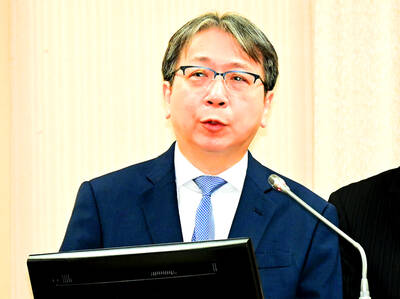President Chen Shui-bian (
"There's no such problem as `one China with each side's individual interpretations' (
Chen made the remarks yesterday morning while attending a members' conference of the Tainan County and City Association in Taishan, Taipei County. Chen is a native of Tainan County.
Chen said that the Republic of China (ROC) used to rule China when it was founded in 1911. Then it became the ROC on Taiwan when the Nationalists lost the civil war and relocated to Taiwan in 1949.
Three countries
"Now the Republic of China is Taiwan. Therefore, there's three countries on each side of the Taiwan Strait and they're the ROC, the People's Republic of China (PRC) and Mongolia," he said.
The former KMT administration used to claim sovereignty over China, Tibet and Mongolia, a stance that caused tension between Taiwan and the three countries.
Many of the problems between Taiwan and Tibet were resolved in January this year when a new Taiwan-Tibet Exchange Foundation was established to take over the Cabinet-level Mongolian and Tibetan Affairs Commission.
Ties between Taipei and Ulan Bator improved dramatically early last year after the Cabinet revised the laws governing Taiwan-China relations and removed claims that Mongolia was part of Chinese territory "to comply with international realities."
The two countries followed up on this diplomatic exchange by opening representative offices in each other's capitals late last year.
Moving away from the KMT's long-time policy of unification with China, Lien surprisingly announced on Saturday during a campaign rally in Taipei that "on each side [of the strait], there's a country."
Lien, however, asked whether Chen's "one country on each side" theory was actually advocating "three countries on either side." The "three countries" were the PRC , the ROC and the virtual "Republic of Taiwan," he said.
Changing strategy
While the pan-blue alliance used to embrace the "1992 consensus," or the notion of "one China, with each side making its own interpretation," it continued to change its cross-strait strategy over the years.
PFP Chairman James Soong (宋楚瑜) once proposed "integration under a one-China roof."
KMT Chairman Lien Chan (連戰) confederated Soong's dictum to the recent "two-Chinas status quo."
Legislative Speaker Wang Jin-pyng (王金平), who heads the pan-blue alliance's presidential campaign headquarters, said last Tuesday that the pan-blue bloc will shift its strategy to maintain the status quo and pursue cross-strait stability, and that it will not rule out Taiwanese independence.
Commenting on the blue camp's policy flip-flop, Chen Chung-hsin (陳忠信), director of the DPP's Chinese Affairs Department, said that Lien owes the public an explanation regarding its China policy.
"When President Chen first introduced the `one country on each side' theory, Lien criticized it harshly. Now he turned around to endorse it, but still didn't have the guts to say that Taiwan is an independent sovereign country," he said.
"He should tell the electorate exactly what he means by `one country.' Is it the Republic of China or is it the People's Republic of China?" he said.

The US government has signed defense cooperation agreements with Japan and the Philippines to boost the deterrence capabilities of countries in the first island chain, a report by the National Security Bureau (NSB) showed. The main countries on the first island chain include the two nations and Taiwan. The bureau is to present the report at a meeting of the legislature’s Foreign Affairs and National Defense Committee tomorrow. The US military has deployed Typhon missile systems to Japan’s Yamaguchi Prefecture and Zambales province in the Philippines during their joint military exercises. It has also installed NMESIS anti-ship systems in Japan’s Okinawa

TRAGEDY STRIKES TAIPEI: The suspect died after falling off a building after he threw smoke grenades into Taipei Main Station and went on a killing spree in Zhongshan A 27-year-old suspect allegedly threw smoke grenades in Taipei Main Station and then proceeded to Zhongshan MRT Station in a random killing spree that resulted in the death of the suspect and two other civilians, and seven injured, including one in critical condition, as of press time last night. The suspect, identified as a man surnamed Chang Wen (張文), allegedly began the attack at Taipei Main Station, the Taipei Fire Department said, adding that it received a report at 5:24pm that smoke grenades had been thrown in the station. One man in his 50s was rushed to hospital after a cardiac arrest

‘WIN-WIN’: The Philippines, and central and eastern European countries are important potential drone cooperation partners, Minister of Foreign Affairs Lin Chia-lung said Minister of Foreign Affairs Lin Chia-lung (林佳龍) in an interview published yesterday confirmed that there are joint ventures between Taiwan and Poland in the drone industry. Lin made the remark in an exclusive interview with the Chinese-language Liberty Times (the Taipei Times’ sister paper). The government-backed Taiwan Excellence Drone International Business Opportunities Alliance and the Polish Chamber of Unmanned Systems on Wednesday last week signed a memorandum of understanding in Poland to develop a “non-China” supply chain for drones and work together on key technologies. Asked if Taiwan prioritized Poland among central and eastern European countries in drone collaboration, Lin

ON ALERT: Taiwan’s partners would issue warnings if China attempted to use Interpol to target Taiwanese, and the global body has mechanisms to prevent it, an official said China has stationed two to four people specializing in Taiwan affairs at its embassies in several democratic countries to monitor and harass Taiwanese, actions that the host nations would not tolerate, National Security Bureau (NSB) Director-General Tsai Ming-yen (蔡明彥) said yesterday. Tsai made the comments at a meeting of the legislature’s Foreign Affairs and National Defense Committee, which asked him and Minister of National Defense Wellington Koo (顧立雄) to report on potential conflicts in the Taiwan Strait and military preparedness. Democratic Progressive Party (DPP) Legislator Michelle Lin (林楚茵) expressed concern that Beijing has posted personnel from China’s Taiwan Affairs Office to its